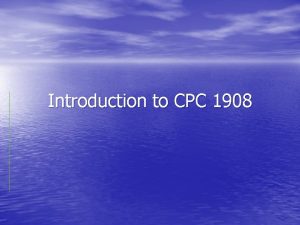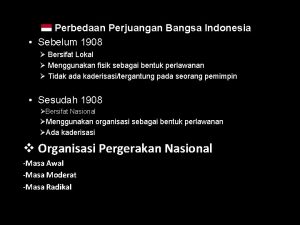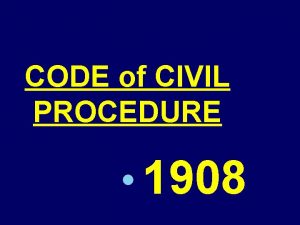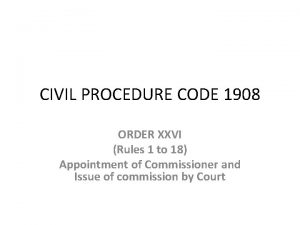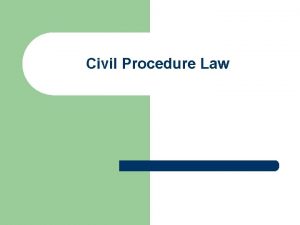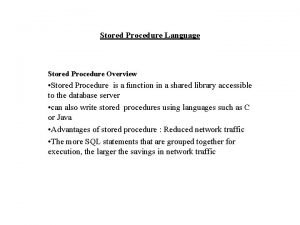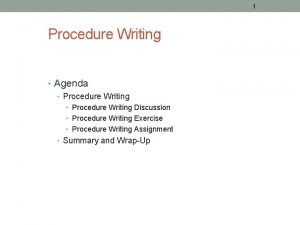CIVIL PROCEDURE CODE 1908 n n Introduction It












- Slides: 12

CIVIL PROCEDURE CODE, 1908 n n Introduction: It consolidates the law relating to procedure of Civil Courts. Scheme of the Act: - It has 158 sections in the first part (the main part) and 51 ORDERS in the second part containing Rules. The Sections contain the fundamental principles, and thus create jurisdiction, whereas the Rules deal with the detailed procedure as to how the jurisdiction should be exercised.

Some Basic Terms (S. 2) n n n n n 1) Decree (2) 2) Decree-holder (3) 3) Government Pleader (7) 4) Judge (8) 5) Judgement (9) 6) Judgement-debtor (10) 7) Legal representatives (11) 8) Mesne profits (12) (9) Order (14)

Parties to a Suit n n n q n n Parties - The rival set of contesting persons in a suit; Suit - An original civil Proceeding between two or more rivals; Plaintiff- The party approaching the Court seeking relief; Defendant - The party against whom the suit is filed and relief sought; There may be more than one plaintiff or defendant in a single suit the qualification is that the right of relief should arise out of the same act or acts or transactions (Order I Rule 3 CPC); The Court can however itself order separate trials to preclude embarrassment or delay (Order I Rule 3 and 3 (A);

Necessary and Proper parties q q • q o A party is considered “necessary” in a suit if the facts of the case indicate that no effective or meaningful decision can be arrived at in his absence, e. g, a tenant himself in a suit for evicting a sub-tenant; In the event of a necessary party not having been joined in the suit; The suit is liable to be defeated (due to non-joinder; Order I Rule 9, Privso); Sometimes an unnecessary party is joined in the suit, e. g. , the minor son of a tenant in a suit for eviction even though residing with his father; But the suit does not suffer for such mis-joinder (Order I rule 9 CPC); q Objections against mis-joinder or non-joinder of parties to be taken at the earliest opportunity (Order I Rule 13); q Court can strike out or add parties in its discretion Suo motto or on the application of any party (Order I Rule 10 (2)CPC );

Pleadings (Orders VI to VIII CPC) n n n Pleading means plaint or written statement (Order VI Rule 1); Plaint - The detailed application submitted by the plaintiff in Court seeking relief against the defendant; Written Statement – The defendants’ detailed reply to the Plaint filed to contest the suit;

Pleadings Generally (Order VI) n n n Pleadings are only statements of Material facts; not evidence (R. 2); Pleadings require particulars of alleged breaches, or the conditions precedent (Rs. 4 & 6); Pleadings signed by party and pleader (R. 14); Disclosure of party’s registered address (R. 14 A); Pleadings to be verified (R. 15);

� Amendment of pleadings (Order VI Rule 17) o o o Normally parties not permitted to amend; Amendments however may be allowed for determining “ the real questions in controversy”; Terms and conditions may be imposed by Court; Normally no amendment after commencement of trial; Rejection of amendment in spite of obtaining leave (R. 18);

Plaint (Order VII): n Contents (R. 1): - n Name of Court, Particulars of Plaintiff, Particulars of Defendant Statement of either party’s special status, Cause of action and its date of accrual, n Showing Court’s jurisdiction, n n n n Relief claimed, Amount of relinquishment / Set-off; Valuation for Court-Fees;

Contents of Plaint (Contd. ) Precise amount in Money suits (R. 2); Approximate amount or value in some cases (proviso); � Description of immovable property (Rule 3); � Plaintiff’s status as representative (Rule 4); � Defendant’s interest and liability (Rule 5); � Grounds for exemption from limitation (Rule 6); � Specific statement of relief (Rule 7); �

Return of Plaint (Rule 10 ) n For presentation in proper Court; n After intimation to defendant (Rule 10 A); n Rejection of Plaint (Rule 11) n No cause of action; Undervalued and failure to correct valuation; Insufficiently stamped; Barred by any law; Failure to correct clerical errors like not filing of sufficient copies; n Documents relied upon to be annexed (R. 14) n n

Written Statement, Set-off & Counter-claim (Order VIII) q � n n n WS to be filed within 30 / 90 days of service (R. 1); WS to contain: Documents relied upon in a defence (R. 1 A); Specific plea of new facts (R. 2); Specific denials (3); No evasive denials (4); Failure to deny specifically causes presumption of admission subject to Court’s discretion (R. 5); Particulars of set-off (Rule 6);

Counter Claim by defendant (Rule 6 A) n Counter Claim is in a way the defendant’s own plaint against plaintiff; n Treated as a cross-suit; n Plaintiff to file WS; n To be governed by rules of a plaint;
 Introduction to cpc
Introduction to cpc Civil rights and civil liberties webquest
Civil rights and civil liberties webquest Jda canada
Jda canada 5 basic human needs
5 basic human needs Perbedaan perjuangan indonesia sebelum 1908
Perbedaan perjuangan indonesia sebelum 1908 Picasso apollinaire
Picasso apollinaire In 1908, ahea stands for
In 1908, ahea stands for Portrait of pablo picasso by juan gris
Portrait of pablo picasso by juan gris Pirandello saggio 1908
Pirandello saggio 1908 Crisis de bosnia 1908
Crisis de bosnia 1908 Robin hood y lady marian
Robin hood y lady marian Saggio breve pirandello
Saggio breve pirandello White city olympics 1948
White city olympics 1948
